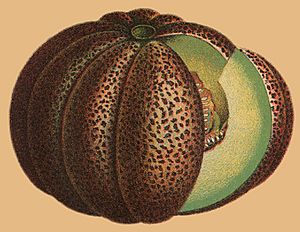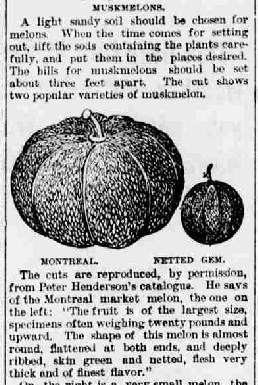Montreal melon facts for kids
Quick facts for kids 'Montreal Market' |
|
|---|---|
 |
|
| Genus | Cucumis |
| Species | Cucumis melo |
| Cultivar | 'Montreal Market' |
| Origin | Introduced by Washington Atlee Burpee, 1881 |
The Montreal melon is a special type of melon. People also call it the Montreal market muskmelon or the Montreal nutmeg melon. In French, it's known as melon de Montréal. This melon was recently found again and is now grown in the Montreal, Quebec, Canada, area. It is a specific kind of plant, called a cultivar, of the Cucumis melo species.
History of the Montreal Melon
The Montreal melon was first grown a long time ago. It grew a lot between the St. Lawrence River and Mount Royal. This area is known as the Montreal Plain.
When the Melon Was Popular
From the late 1800s until World War II, this melon was very popular. It was one of the most liked melons on the east coast of North America. The fruit itself was quite big. It was larger than any other melon grown there at the time.
What the Melon Looked Like
The Montreal melon was round and flat on its ends. It had deep ribs, like lines, on its skin. The skin was netted, similar to a muskmelon, and very thin. Inside, the flesh was light green. It almost melted in your mouth when you ate it. Many people said its spicy taste reminded them of nutmeg.
Melon Sales and Size
Newspaper stories from the early 1900s show the melon was also grown in Vermont. Farmers found it brought in a lot of money. In 1907, a dozen melons sold for about $10 wholesale. Each melon could sell for $1.25 to $1.75 in stores.
Reports from the late 1800s talked about how big these melons could get. Some weighed over 20 pounds each! One report said: "The fruit is of the largest size, specimens often weighing twenty pounds and upward. The shape of this melon is almost round, flattened at both ends, and deeply ribbed, skin green and netted, flesh very thick and of finest flavor."
Rediscovering the Melon
The Montreal melon started to disappear as Montreal city grew. Its thin skin was good for small family farms. But it was not good for large-scale farming, called agribusiness.
After many years, the melon was found again. In 1996, seeds were discovered in a seed bank. This bank is kept by the U.S. Department of Agriculture in Ames, Iowa. Now, the Montreal melon is becoming popular again. Many gardeners in the Montreal area are growing it.
How to Grow Montreal Melons
Growing Montreal melons needs special care. Here's how it was done in 1909:
Starting the Seeds Indoors
Gardeners would plant the seeds indoors. This happened in a greenhouse or a hotbed. They planted them from late February to early April. Later, the young plants were moved into small pots.
Moving Plants to Frames
When the plants grew bigger, they needed more space. They were moved to special frames covered with sashes. These frames stayed there until the melons were almost fully grown. The hotbeds were built well to catch the sun. They also protected the plants from cold winds. Sometimes, the frames had two layers of sash covers. They also used mats and wooden shutters for extra protection.
Preparing the Soil
To keep the plants warm, horse manure was used. It created heat from below the plants. The soil where the frames were placed was raised into beds. These beds were 12 to 16 feet wide. A trench was dug about 2 feet wide and 15 to 18 inches deep. This trench was filled with well-rotted manure. Then, some surface soil was put over it. A bit more soil was added where the plants would be placed.
Planting and Care
The frames were then set over the prepared soil. They were covered with sashes, mats, and wooden shutters. When the soil was warm enough, the plants were carefully moved. This was done on a warm day to avoid shocking the plants. Even after planting, the melons needed a lot of care. Watering, spraying, and air flow were very important for success.
Protecting the Fruit
As the melons grew, they were often lifted off the soil. This was done using a shingle or a flat stone. This stopped them from cracking or rotting. To make sure the melons grew evenly, they were turned every few days. This helped them get a uniform shape, color, and netting.
Harvesting and Yield
When the melon vines filled the covered area, the frames were raised. As the weather got warmer, more air was let in. Finally, when the melons were almost fully grown, the sash covers were removed. Then, the frames themselves were taken away.
For each fruit that started to grow, the shoot was pinched off. This was done one or two joints beyond the fruit. From a 6 by 12-foot frame, about 15 to 20 melons were considered a good crop. Usually, three or four small mounds of soil, called hills, were planted. Two plants were set in each hill.
Melon Size and Quality
The size of the melons could vary a lot. One melon was even reported to weigh 44 pounds! A writer saw one that weighed 22 pounds, which was saved for seeds. Most Montreal melons weighed between 8 and 15 pounds. A dozen melons usually weighed about 120 to 130 pounds. Sometimes, a dozen could weigh up to 240 pounds for shipping. However, the very largest melons were often not as good in taste as those weighing 8 to 15 pounds.
Images for kids



